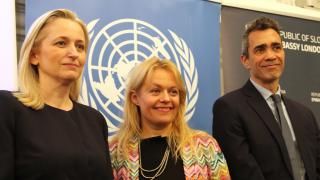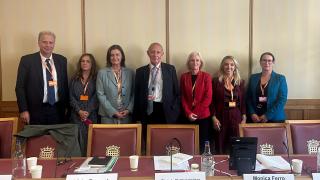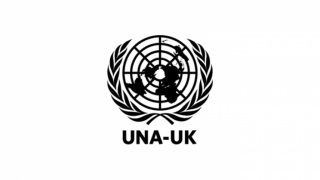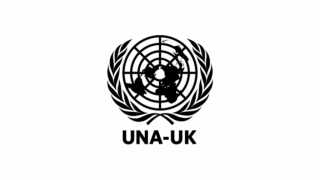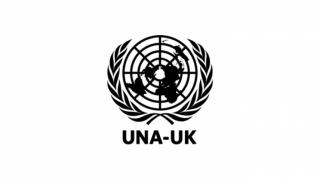
UNA-UK’s Head of Policy, Fred Carver, is in the Democratic Republic of Congo looking at the work of the UN mission: MONUSCO, the largest and most complex of all the UN’s peacekeeping operations.
He has been observing some of the work that the Mission has been doing to prevent Sexual Exploitation and Abuse, a problem that threatens to overshadow the UN’s vital role in preventing a return to conflict and promoting a more stable and safer Congo.
Day 1
I arrived in Goma after a long journey – the UN’s air service is friendly and efficient, but Goma is quite hard to get to from London. I travelled from there to the Eastern Division HQ, which is spilt across two sites by the side of Lake Kivu. Having arrived late there was time to work up an itinerary, but not to do much else, and so off to my hotel for some much-needed sleep.
Day 2
In the morning I visited the South African helicopter unit. Nearly 150 strong, this unit operates two types of helicopter. The first is the Oryx transporter (“you call, we haul”) which does emergency medical evacuations and is used to insert troops and evacuate civilians from dangerous areas. The second is the Rooivalk, a South African built attack helicopter. It provides cover for emergency evacuations in hostile areas and can protect civilians and UN bases that come under attack. Budget cuts have meant fewer flying hours of late, which they feel makes performing their task more difficult.
Day 2 continued...
I also heard about their project supporting a local orphanage with donations and by rebuilding their spent ammo containers into chairs and desks for the orphanage and its school.
They have a barracks on site, a small (and slightly flooded!) gym and their pride and joy – a barbecue pit. Spirits were high because the two-weekly transport plane from South Africa had just arrived with supplies and letters from home. The unit call its day of arrival “Christmas” because of the presents it brings.
In the afternoon I met URUBAT, the Uruguayan battalion which, as MONUSCO’s reserve force, gets sent into all of DRC’s hotspots. Their Goma base, over which the imposing Mount Nyiragongo looms (see Day 4 pic), is delightful – with its own gardens and multiple murals painted by the soldiers themselves. They took me through what “Protection of Civilians” means in practice: a community liaison tells them in which villages trouble is brewing and they then turn up in force to be met, on at least two recent occasions, with hostile fire. By taking back control over such villages they feel they’re implementing two key parts of the mission mandate: protecting civilians from harm and neutralising armed groups.
WATCH: @CarverUNA reporting from @monusco in Goma. The UN is doing a lot to combat sexaul exploitation and abuse by peacekeepers. Let's give them the support they need by pushing for accountability. @UNAUK pic.twitter.com/UWKtvnpVwJ
— Mission Justice (@Beyond2272) March 5, 2018
They also took me for a drive in one of their armoured personnel carriers (APCs) – it turns out the insides of them are not built to clamber around in with a large camera wrapped around your neck!
Then back to MONUSCO HQ for meetings with those responsible for the Conduct and Discipline Unit and – by extension – the UN’s response to sexual exploitation and abuse. I also met an intelligence officer and one of the five UK members of the mission – his role is to understand the needs, goals and threats posed by the 80 odd armed groups in the region, so that they can be disarmed.
Day 3
I was awoken by the sound of singing. Troops of the Congolese armed forces often go running down the streets of Goma in the early morning and they sing as they run.
A fairly quiet day which I used to shoot some video (see above and have a look at our Twitter) but I did have a detailed briefing from the intelligence officer of Central Command. The Command covers an area of nearly half a million square kilometres. Up until 2016 four Indian Battalions had been given responsibility for an area a tenth of the size. Now, as a consequence of budget cuts, there were just three Indian and one Nepali Battalion to control this entire area. This is of course impossible, and so instead the Command was employing a tactic called “Force Projection” where mobile troops, ferried from location to location by helicopter, are able to maintain a presence over a large area, and can be sent rapidly in the direction of trouble spots. It’s a great way to do more with less, but with the reduction of flying hours the Mission is clearly operating close to its financial limit.
In the afternoon I went for a run. This was an error and I got very wet. MONUSCO have a saying: the weather is like the security situation – mostly it is fine, but do not get caught outside when it turns because it can be ferocious!
MONUSCO might be in a French speaking country, but it is actually an Anglophone mission. With 49 different countries contributing troops, a significant number of them from South Asia, it turns out English is actually the lingua Franca!
Day 4
Such trips are, by their nature, unpredictable, and the operation of the mission always has to come ahead of the desires of any visitor. And so it was a shame, but understandable, when my plans for the day – a patrol with Indian peacekeepers, with the Senegalese Police, and then a trip to Sake to visit the Force Intervention brigade – were cancelled at the last minute, giving me a day of leisure.
I spent the day in search of Wi-Fi. Goma, still a fairly Christian place, is very quiet on a Sunday morning and so this was not a short search. I watched some French Football, witnessed a fight (not much of a fight, a security guard and a customer shoving each other in the manner of footballers, knowing that actually raising fists would be an unignorable escalation with armed police only metres away) and, on my return, witnessed an amazing view. Goma is on Lake Kivu, which is a very big lake and the constant haze means I had yet to see the other side. Today the air was clear enough that I could: enormous mountains tower over the lake, which is itself already around 1,500m above sea level. I looked them up afterwards. Mere foothills of the Virunga mountains, they don’t even have their own Wikipedia page, and yet they still tower above the lake. The scale here is enormous. Congo itself is the size of Western Europe, although the terrain is less forgiving and the road network less comprehensive.
Day 5
In the morning I went to the offices of World Vision to get a civil society perspective on the work of the mission. I then went to a small police building out near the airport to meet the President of a Community Based Complaint Mechanism (CBCM).
The Mechanism was established to act as a bridge between the local community and the Conduct and Discipline Unit (CDU) when it comes to acts of sexual exploitation and abuse. Following an information campaign in the local news, churches, schools and NGOs, around 100 people volunteered to be trained in facilitation and sensitivity with regards to abuse complaints. From among their number they elected 23 people to act as members of the mechanism and a President.
Day 5 continued...
They act as the eyes and ears of the CDU in the community, and funnel complaints to the Mission. Members have been given incredibly colourful and intricately designed outfits (see pic) to make them visible in the community.
While the process is far from sufficient, with issues arising around gatekeeping and the ability for victims to access a community-based system due to shame and stigma, nevertheless the CBCM performs valuable work. As the President said, “before the CBCM we all assumed that Peacekeepers had total immunity, now because of the CBCM everybody knows that there is a process for accountability.”
UK contribution to UN Peacekeeping is "vital" - catch up on @CarverUNA's behind-the-scenes blog from @monusco in #DRC: https://t.co/XdwIM9h9Ep @UKUN_NewYork @UNPeacekeeping @IBVprev @pass_blue @WFUNA @StewartWood @BetterWorldOrg @AIDS_Free_World pic.twitter.com/aH2kZcLV28
— UNA-UK (@UNAUK) March 6, 2018
On the way back we went past a man on a truck dressed as a waist coated cowboy except for his beige wellington boots. He was addressing a crowd through an enormous sound system that dominated the truck. I initially assumed this was something political but it turns out he was selling cigarettes.
An afternoon packed with meetings: political affairs, protection of civilians, civil affairs … and saying goodbye to my wonderful hosts. Tomorrow I leave at 6am. Watch this space for further updates and reflections on my time here.


